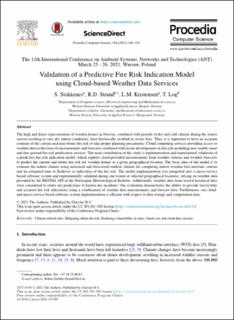| dc.contributor.author | Stokkenes, Sindre | |
| dc.contributor.author | Strand, Ruben Dobler | |
| dc.contributor.author | Kristensen, Lars Michael | |
| dc.contributor.author | Log, Torgrim | |
| dc.date.accessioned | 2021-09-30T11:19:54Z | |
| dc.date.available | 2021-09-30T11:19:54Z | |
| dc.date.created | 2021-05-18T12:03:29Z | |
| dc.date.issued | 2021 | |
| dc.identifier.citation | Stokkenes, S., Strand, R. D., Kristensen, L. M., & Log, T. (2021). Validation of a Predictive Fire Risk Indication Model using Cloud-based Weather Data Services. Procedia Computer Science, 184, 186-193. | en_US |
| dc.identifier.issn | 1877-0509 | |
| dc.identifier.uri | https://hdl.handle.net/11250/2786606 | |
| dc.description.abstract | The high and dense representation of wooden homes in Norway, combined with periods of dry and cold climate during the winter season resulting in very dry indoor conditions, have historically resulted in severe fires. Thus, it is important to have an accurate estimate of the current and near future fire risk to take proper planning precautions. Cloud computing services providing access to weather data in the form of measurements and forecasts combined with recent developments in fire risk modelling may enable smart and fine-grained fire risk predication services. The main contribution of this study is implementation and experimental validation of a predictive fire risk indication model, which exploits cloud-provided measurements from weather stations and weather forecasts to predict the current and future fire risk for wooden homes at a given geographical location. The basic idea of the model is to estimate the indoor climate using measured and forecasted outdoor climate for computing indoor wooden fuel moisture content and an estimated time to flashover as indication of the fire risk. The model implementation was integrated into a micro-service based software system and experimentally validated during one winter at selected geographical locations, relying on weather data provided by the RESTful API of the Norwegian Meteorological Institute. Additionally, weather data from several historical fires were considered to relate our predictions to known fire incidents. Our evaluation demonstrates the ability to provide trustworthy and accurate fire risk indications using a combination of weather data measurements and forecast data. Furthermore, our cloud-and micro-service based software system implementation is efficient with respect to data storage and computation time. | en_US |
| dc.language.iso | eng | en_US |
| dc.publisher | Elsevier | en_US |
| dc.rights | Attribution-NonCommercial-NoDerivatives 4.0 Internasjonal | * |
| dc.rights.uri | http://creativecommons.org/licenses/by-nc-nd/4.0/deed.no | * |
| dc.title | Validation of a Predictive Fire Risk Indication Model using Cloud-based Weather Data Services | en_US |
| dc.type | Journal article | en_US |
| dc.type | Peer reviewed | en_US |
| dc.description.version | publishedVersion | en_US |
| dc.rights.holder | © 2021 The Authors | en_US |
| dc.subject.nsi | VDP::Mathematics and natural science: 400::Information and communication science: 420 | en_US |
| dc.source.pagenumber | 186-193 | en_US |
| dc.source.volume | 184 | en_US |
| dc.source.journal | Procedia Computer Science | en_US |
| dc.identifier.doi | 10.1016/j.procs.2021.03.029 | |
| dc.identifier.cristin | 1910459 | |
| dc.relation.project | Norges forskningsråd: 298993 | en_US |
| cristin.ispublished | true | |
| cristin.fulltext | original | |
| cristin.qualitycode | 1 | |

